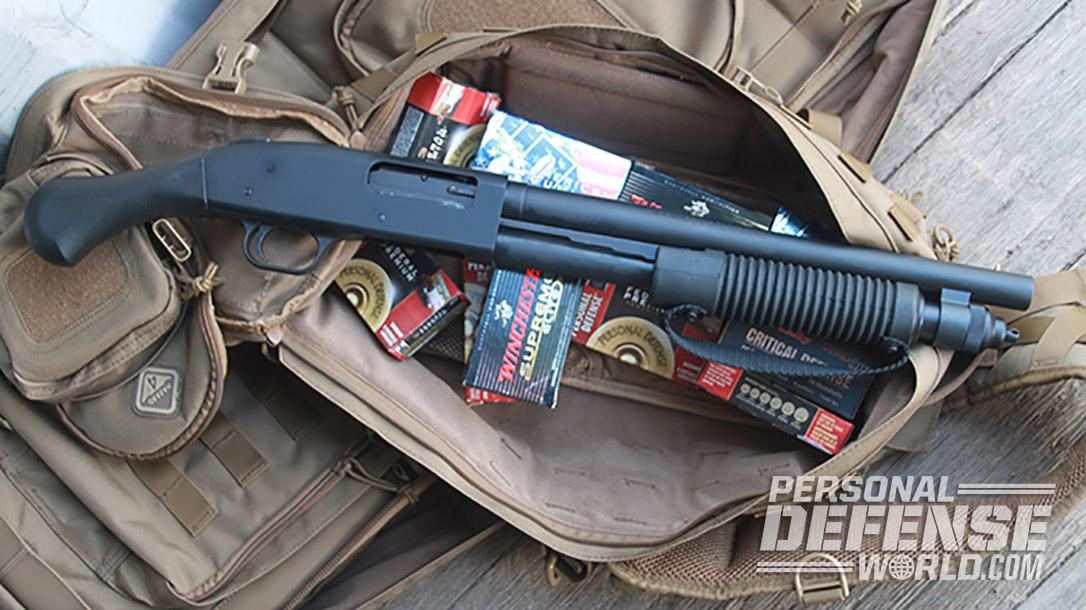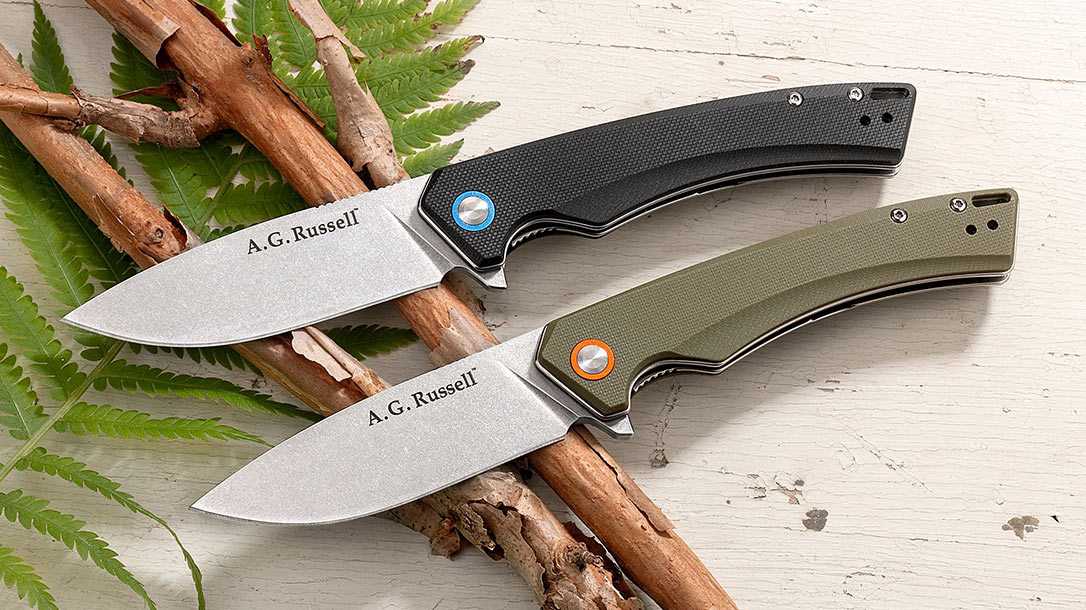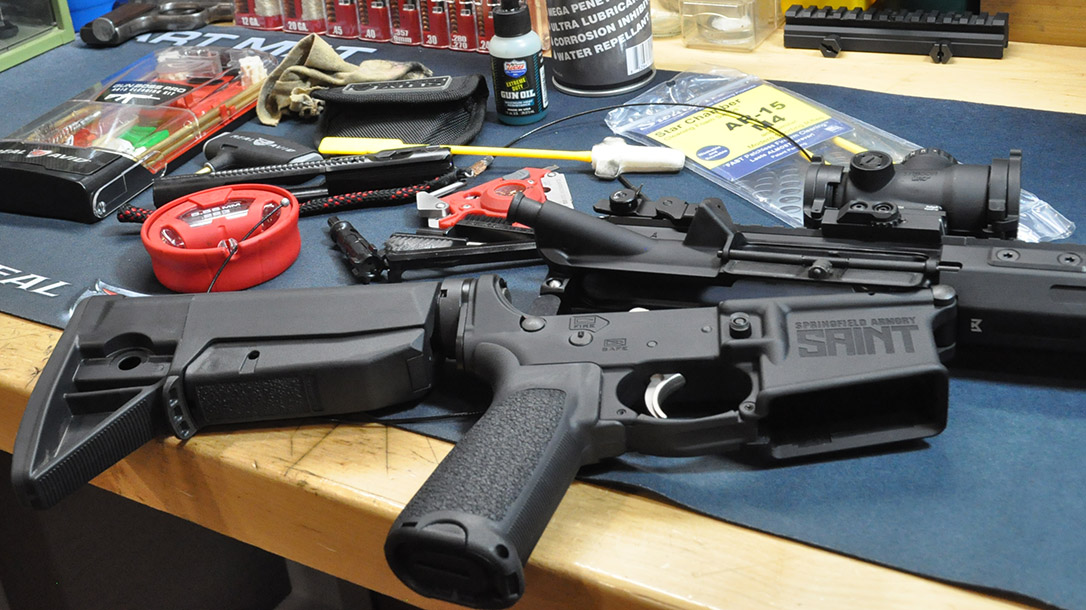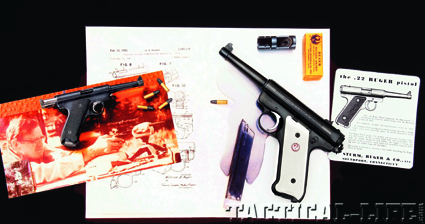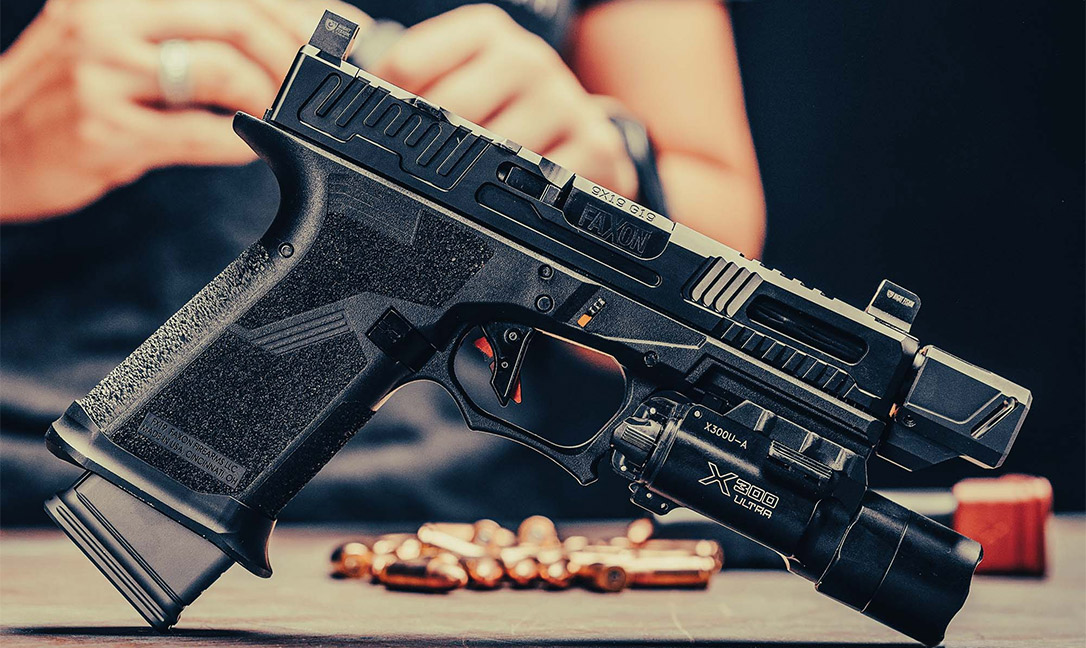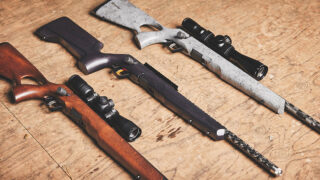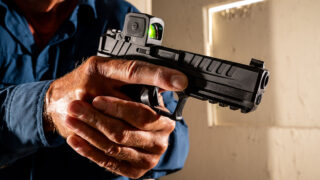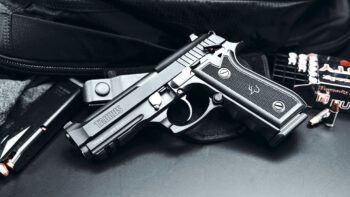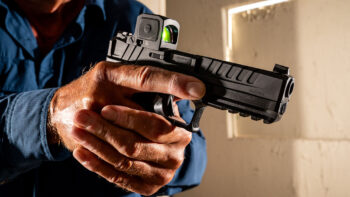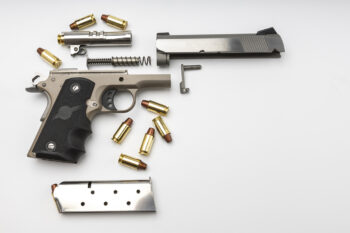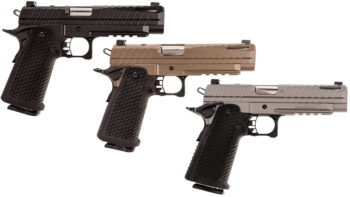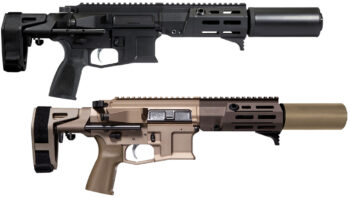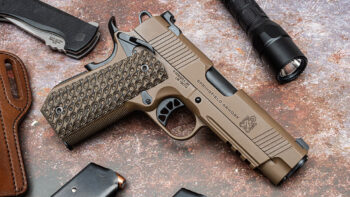Two Athlon Editors Review the Mossberg Shockwave 12-Gauge Shotgun
If someone asks for firearms advice for home defense, what comes to mind? The answers received will surely vary depending on the questioner’s perceived overall skill and each respondent’s own level of training and experiences. No doubt some would offer up the utilitarian 12-gauge, pump-action shotgun as the best option. This is based on the gun’s simplicity, flexibility, reliability, price and potency, especially considering the distances that typify home-defense situations. Well, the new 12-gauge Mossberg 590 Shockwave might just be the perfect choice for this role.
The Details on the Mossberg Shockwave
Pump-action shotguns have been around for a long time. Many casually dismiss the shotgun as being no longer viable; they’re considered relics associated with WWI trenches or police cruisers that have been surpassed by the plethora of black rifles now on the market. But the combat shotgun’s utility should not be doubted or held in disdain once its role is understood.
Whatever their label—combat, tactical, self-defense—shotguns can be had in various forms ranging from double-barreled, pump-action, semi-auto and even lever-action designs. The Mossberg 590 Shockwave takes this a step further. It features a Raptor bird’s-head grip and a 14-inch barrel. Do not stop reading this article by assuming it involves NFA Class 3 restrictions. The Mossberg 590 Shockwave can be purchased with the basic paperwork associated with most any other over-the-counter firearm purchase.
A review of the Gun Control Act of 1968 that defines the characteristics of a short-barreled shotgun (SBS) is the key. Since the Shockwave is manufactured from the start with a Raptor bird’s head grip and maintains an overall length greater than 26 inches, it is considered a regular firearm and not an NFA-regulated item, even with its 14-inch barrel.
Close-Range Defender
The inherent flexibility of shotguns, especially pump actions, to digest a variety of ammo types such as birdshot, slugs, buckshot, less-lethal, low-recoil, breaching, etc., is their greatest attribute. The Mossberg Shockwave tested herein is a pump action with polymer furniture and an alloy receiver that will handle all of these rounds while exuding an all-business air.
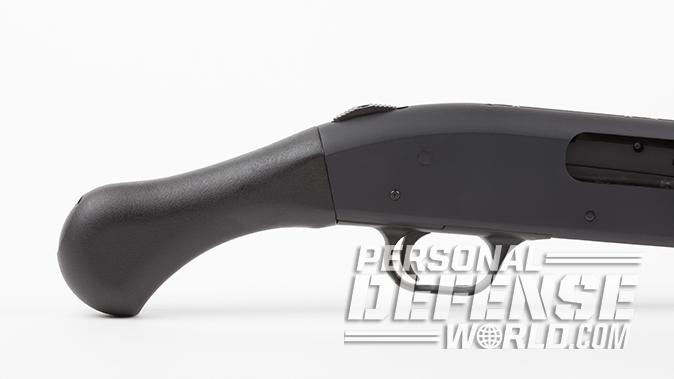
Research into the Shockwave concept shows serious influence from a similar model used by the U.S. Marshals Witness Protection Program. Other anecdotes mention various law enforcement units specializing in stakeout surveillance turning to the close-range firepower potential of the compact shotgun. High-value prisoner transport teams have also made use of shotguns similar to the Shockwave.
No one can be all-knowing in every facet of a subject as broad as personal defense. One of the places I look to for keeping me informed and grounded is Suarez International, which contains different operating entities ranging from a training division, a tactical gear store and even its own custom firearm manufacturing division.
Suarez International’s Approach
Gabriel Suarez is the owner and CEO of Suarez International. He is a controversial figure for a variety of reasons, including his outside-the-box thinking when it comes to the methods and tools that best serve individuals in personal-defense situations. But you can be sure that any ideas or products presented by Suarez are well thought out and proofed during numerous training cycles and personal application in the field under the most rigorous conditions.
Suarez International is offering its own take on the pistol-grip shotgun with its Stakeout model. This is what made me take notice of the concept and so willing to explore the concept in the form of the Mossberg 590 Shockwave.
We depend on subject-matter experts for recommendations and guidance. This approach assists in getting us up to speed as quickly as possible when increasing skillsets. My testing of Mossberg’s Shockwave was based on Suarez’s quality videos and articles discussing best practices with pistol-grip shotguns. For example, firing from the hip is not the best way to deploy the Shockwave effectively.
My Firing Experience
Bringing the Shockwave up to eye level, while keeping it out in front, away from your face, produced the best on target results. Recoil was managed by maintaining forward pressure on the forend in conjunction with a rearward pull on the bird’s-head pistol grip. Gabe describes it as trying to stretch the shotgun apart. Recoil with the Shockwave is stout, and anyone telling you any different should be scrutinized. Proper technique is important, as is taking advantage of the growing amount of low-recoil shotgun rounds becoming available. The Mossberg 590 Shockwave is also not for smaller-statured shooters.
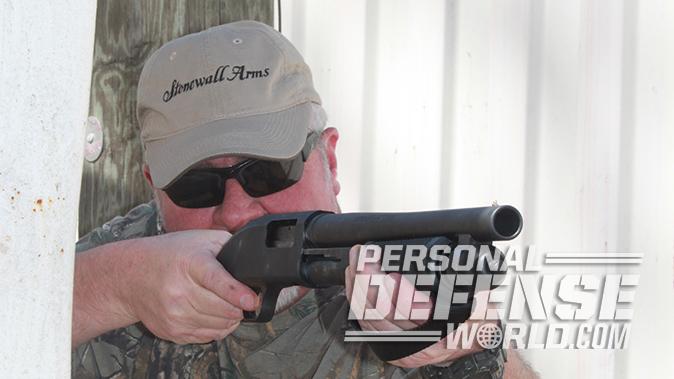
The receiver of the Mossberg Shockwave is constructed of aircraft-grade aluminum with the bolt locking into a steel barrel extension. The weapon is designed to facilitate maintenance under field conditions, with easy access to internal components. The magazine has a removable end cap, spring and follower for straight-through cleaning. It’s also easy to remove the barrel for detailed cleaning and maintenance.
The receiver-mounted safety is convenient for right or left-handed shooters; simply push the button forward and you’re ready to fire. In addition, the 590 features an anti-jam elevator for reliable feeding and dual extractors for positive extraction/ejection.
Up Close & Personal
There is something reassuring about the power of a shotgun for any close-range engagement, which is what most civilians face. In terms of personal defense, buckshot loads predominate. Yes, other loads exist, but they’re frankly not relative to the role envisioned with the Mossberg Shockwave.
There are various types of buckshot, but we will confine our discussion to 00 buckshot shells generally loaded with eight or nine .33-caliber pellets weighing 54 grains each. (As a side note, many advocate the use of #71/2 or #8 birdshot in a shotgun for use in a home to limit any chance of overpenetration. A column of birdshot at close range such as across a room is lethal due to not having time to disperse.)
For 00 buckshot testing, I used Hornady’s Reduced Recoil ammo as well as Federal’s Low Recoil FliteControl rounds. The Federal Premium buckshot load utilizes a special wad for tighter buckshot patterns, thus a longer effective range. Based on prior experiences and exposure to numerous shotguns and loads over the years, specialized buckshot loads such as the Federal Premium FliteControl are a primary choice.
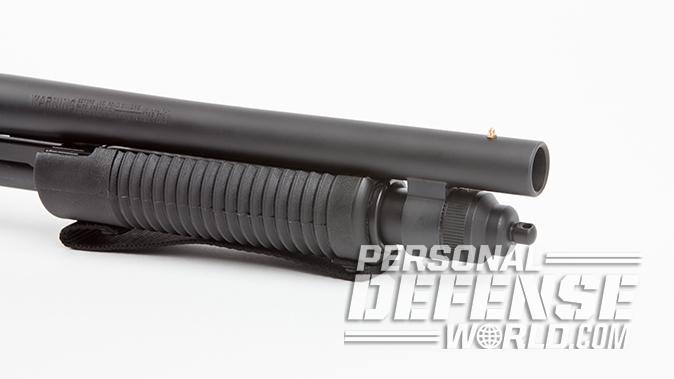
However, the role of the Shockwave as a close-range blunderbuss could justify the use of conventional-patterning buckshot. The newer buckshot loads with specialized wads could maintain too tight a pattern at distances most associated with practical deployment of the 590 Shockwave, limiting one of the greatest attributes of a shotgun: lead dispersal. Users will have to determine what bests suits their needs.
Winchester PDX1
Supplementing the buckshot for testing with the Mossberg Shockwave was the innovative 12-gauge Winchester PDX1 loading combining a 1-ounce slug and three 00 pellets. The Winchester PDX1 load harkens back to the “buck and ball” loads used by our forefathers against the British in the Revolutionary War and each other during the Civil War. These loads stretch preconceived 12-gauge lethality notions even further with their combination of slug and buckshot.
Range testing of the Winchester PDX1 raised eyebrows, combining single-projectile performance and a 10-inch pattern spread out to 20 yards—with one of the holes being made by the 1-ounce slug. If you could choose only one load for use in a combat shotgun, the Winchester PDX1 may very well be it.
Drill Time
I evaluated the 590 via drills involving moving between barricades; think emerging from a bedroom into a hallway. Another niche role the pistol-grip shotgun found in the law enforcement arena is as a CQB force multiplier, especially in and around vehicles. So I used the Echo Valley Training Center’s range cars to simulating responding to ambushes.
The Shockwave has a 5+1 capacity, which I augmented with a Mesa Tactical four-shell carrier on the receiver. Frankly, the role the Shockwave is envisioned for will not require more than this capacity. If the situation allows for or demands more volume, a BlackHawk bandoleer and forearm shell holder are two of the more successful ways. Also, you can look to the BlackHawk Omega tactical shotgun vest to carry more ammunition. If a user requires a more discreet method, however, shotgun rounds can simply be carried in pockets.
My initial hesitancy and concerns about recoil management were allayed thanks to firing technique, the bird’s-head grip and the low-recoil buckshot rounds. I discovered a rhythm, making the most of the natural recoil impulse to rack the slide, eject the spent hull, load a fresh shell and bring the Shockwave back up to my line of sight. The centrally located safety was simple to find and manipulate as required.
Final Thoughts
What is so attractive about the pump-action Mossberg Shockwave? It boils down to the its simplicity, reliability and close-quarters lethality. At point-blank range, the Shockwave’s near-0.75-inch-diameter bore is devastating. Buckshot’s natural dispersion as it travels downrange creates an impressive cone of firepower.
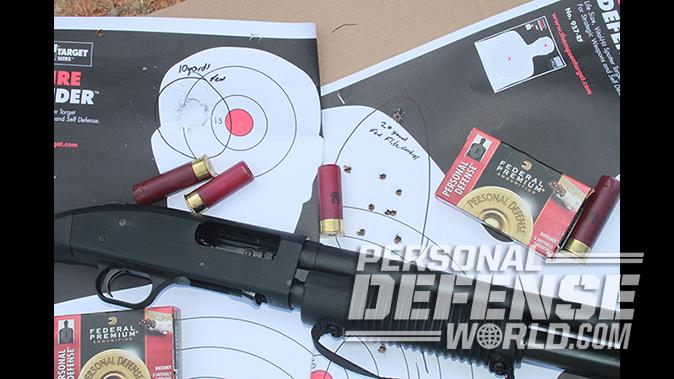
A 6-inch-diameter pattern at 10 yards translates into a 1-square foot area of terminal ballistic destruction. Eight or nine .33-caliber pellets smashing into a target will stop any fight. The Mossberg 590 Shockwave is a specialized weapon created for close-range superiority. Give it a try. For even more info, visit mossberg.com.
Mossberg Shockwave Specs
| Gauge: 12 |
| Barrel: 14 inches |
| OA Length: 26.37 inches |
| Weight: 5.25 pounds (empty) |
| Grip: Shockwave Raptor |
| Sights: Bead front |
| Action: Pump |
| Finish: Blued |
| Capacity: 5+1 |
| MSRP: $455 |
Mossberg Shockwave Performance
| Load | Velocity | Pattern |
|---|---|---|
| Federal 00 Personal Defense | 1,150 | 1.75 (10 yards), 4.00 (20 yards) |
| Hornady 00 Reduced Recoil | 1,310 | 3.75 (10 yards), 7.00 (20 yards) |
| Winchester PDX1 Defender | 1,190 | 3.75 (10 yards), 10.00 (20 yards) |
*Velocity measured in fps and pattern in inches.
Another Editor’s Take on the Mossberg Shockwave
Tim Stetzer
Short-barreled shotguns look serious and intimidating. They’re handy in tight spaces and pack a punch well above their weight class in most cases. Traditionally, they’ve also been National Firearms Act (NFA) regulated items that require a $200 tax stamp, all of the associated paperwork and wait times of six months or longer, depending on how quickly the Bureau of Alcohol, Tobacco, Firearms & Explosives (BATFE) can process requests. So, while a stubby scattergun is appealing to many shooters for defense work, their appeal is somewhat limited due to the additional cost and paperwork that has always gone along with them. But what if you could legally get a similar class of weapon without all of the extra cost and paperwork? Then you’d have the new Mossberg Shockwave.
Defying Labels
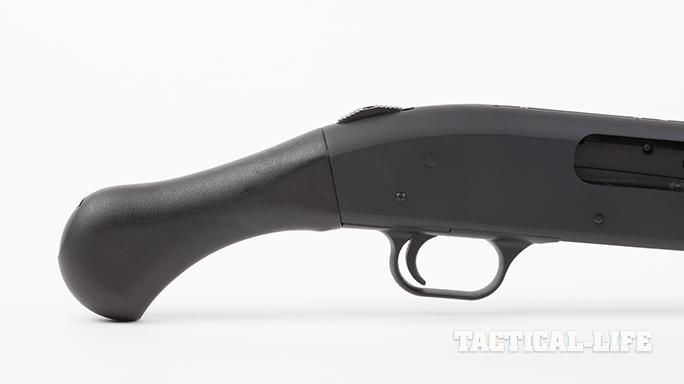
When I wandered up to the Mossberg shooting line during Industry Day at the 2017 SHOT Show, I was greeted by three stubby, pistol-gripped shotguns. I first thought it was neat to see Mossberg jumping into the factory short-barreled shotgun (SBS) and “any other weapon” (AOW) game. But as it turned out, I was only partially correct. There were indeed two AOWs there—the 590 and 500 Compact Cruisers—with pistol grips and 10.25- and 7.5-inch barrels respectively, but the third gun had a 14-inch barrel and sported a Shockwave Raptor bird’s-head grip.
I made a comment about the trio of NFA guns and was politely corrected and informed that the Shockwave was simply a “firearm,” not an AOW or an SBS. Then, I quickly realized what I was looking at. I had actually talked to a Mossberg rep last year about building a gun like this. A couple of smaller companies have dipped their toes into the “firearm” category, but none of the major players in the gun industry had at that point. At the time, they weren’t ready to jump in to the market—or provide a writer the parts to build one on his own and write it up—but I must not have been the only one asking about it, because a year later, here we are.
So what is a “firearm” in NFA jargon, and how does it fit into the scheme of things? The BATFE defines a shotgun as “a firearm designed to be fired from the shoulder and designed to use the energy of the explosive in a fixed shotgun shell to fire through a smoothbore either a number of projectiles or a single projectile for each pull of the trigger.” A shotgun with a barrel or barrels less than 18 inches in length is considered an SBS and subject to a $200 tax as well as all of the regulatory paperwork that goes along with that. A “weapon made from a shotgun” is a shotgun-type weapon that has an overall length of less than 26 inches or a barrel or barrels less than 18 inches in length. That also is subject to the same $200 tax and paperwork.
Then we have the AOW category. An AOW is a weapon or device capable of being concealed on the person from which a shot can be discharged through the energy of an explosive. Included in this definition are pistols and revolvers having smoothbore barrels designed or redesigned to fire a fixed shotgun shell. This basically includes factory-made guns that were never intended to be shoulder fired, under 26 inches in overall length, with smoothbore barrels. An AOW is subject to a $5 tax and the same paperwork as the other NFA firearms. Confused yet?
So, all of the aforementioned firearms are all regulated under the NFA. But the Mossberg Shockwave isn’t any of those—it’s considered a “firearm.” The difference between it and the aforementioned classes is its overall length and the fact that it’s a factory-built gun in that configuration. Although the barrel length of the Shockwave is 14 inches in length, the gun was manufactured with a pistol grip, so it was never intended to be shoulder fired, and it’s over 26 inches long, which puts it into a category not subject to any NFA requirements. It can be bought over the counter on a Form 4473 by anyone 18 years of age or older barring any state laws that might be more restrictive.
Still confused? Just roll with it. It’s a neat class of weaponry that has only really been explored by a few smaller companies, but I expect we’ll see more now that a player like Mossberg has jumped into the arena.
Mossberg Shockwave Details
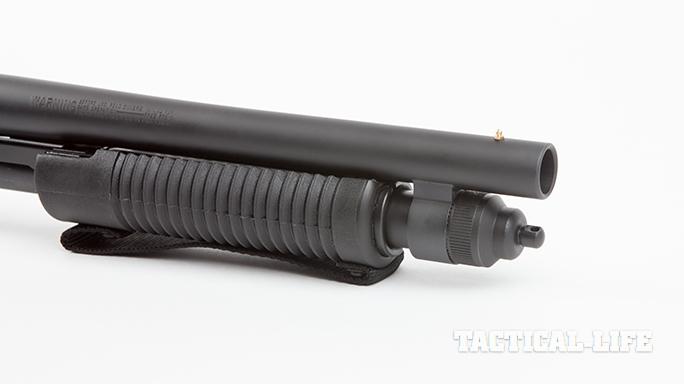
The Mossberg Shockwave is built on the company’s time-tested and military- approved 590 receiver, and it’s fitted with a 14-inch, heavy-walled, cylinder-bore barrel with a bead sight. The aluminum receiver is drilled and tapped for optics, although, honestly, I’m not sure how well those would work on a gun like this. It features twin action bars and a ribbed, polymer forend with a hand strap to keep your support hand away from the stubby muzzle during recoil. An ambidextrous top-mounted safety makes the gun lefty friendly, and dual extractors and an anti-jam elevator ensure reliability.
As mentioned, the gun uses a Shockwave Raptor bird’s-head grip like those used on the old U.S. Marshals Service Witness Protection shotguns. The Raptor grip is the key to the Shockwave’s overall length of 26.37 inches. That length allows for the 14-inch barrel. Any shorter and you’d be looking at an NFA item.
My test gun only featured a sling swivel stud at the end of the magazine tube. However, production models will have one at the base of the grip as well. The magazine holds five 2¾-inch, 12-gauge shells, plus one in the chamber. The gun also weighs 5.25 pounds unloaded, which is 2 pounds lighter than an 18.5-inch-barreled 590 with a full stock. Finally, the MSRP on the Shockwave is only $455; that’s pretty reasonable considering you won’t have to deal with a $200 tax stamp.
How It Shoots

You might ask what it’s like to shoot a 14-inch-barreled 12 gauge with a pistol grip. The answer? It depends. At the SHOT Show, Mossberg was running Aguila Mini-shells through the gun, and it was actually quite pleasant to shoot. The recoil was mild, and follow-up shots were fast. When I needed ammo for my test sample, I reached out to Aguila. I got a quantity of the company’s buckshot, slug and #7½ field loads. I also got my hands on Hornady’s eight-pellet Critical Defense buckshot and 1-ounce American Gunner reduced-recoil slugs. The gun has a 3-inch chamber, but honestly, I had no desire to see what a 3-inch shell would feel like out of a 5.25-pound, pistol-grip shotgun.
At the range, I started with the Aguila Minishells. To aid in loading and feeding, I used a nifty gadget that I saw the Mossberg folks using at Industry Day: The OPSol Mini-Clip. This is a plastic spacer that snaps into the loading port of a Mossberg 500 or 590. It takes up enough space to keep the short Aguila Minishells from rattling around or flipping on the elevator to ensure smooth feeding. It takes only a few seconds to install, and the gun ran flawlessly with it in place. When I tried Minishells in my full-sized 590A1 a few years ago, I had some reliability issues due to the short length of the shells. OPSol seems to have solved this issue with a simple, clever device.
The 1¾-inch Minishells have significantly less recoil than a standard 2¾-inch, 12-gauge shell. However, they still pack a hefty punch, particularly in the buck and slug loads. Aside from reduced recoil, the short shells also give you increased capacity. Rather than the normal 5+1 capacity, you can get 8+1 Minishells. The recoil with the Minishells was downright pleasant; I think just about anyone can handle this ammo without issue.
Moving up to the Hornady loads, the recoil increased significantly, even though these are reduced-recoil tactical loads. We use similar loads in my police department’s 14-inch-barreled Remington 870s. They’re pretty easy shooting with a buttstock, but you definitely know they’re going off with just the Shockwave Raptor grip. With that said, they’re by no means uncontrollable, especially with the hand strap on the forend.
Technique has a lot to do with recoil management, too. I basically found two ways to realistically shoot the Shockwave. One is the basic hip-shooting position with the butt of the Raptor grip tucked in along the hipbone. This method seemed to have the best recoil compensation but sacrificed accuracy—if you can call it that—since you’re truly just pointing the muzzle at the target and shooting. The other method is to bring the gun up into a high tuck, with the grip pulled into and alongside your ribcage. This translates a bit more recoil to your body, but the higher placement makes for more accurate shooting downrange.
I did try shooting the gun from eye level, but I have a few words of caution. First, the Raptor grip places your hand at an odd angle when shooting at eye level. At least I found it a bit awkward. Second, without the gun braced against your body, you’re sacrificing recoil control. You do obviously gain the ability to use the bead sight, however, and aim more precisely. With the Minishells, it’s an option, although it’s still a bit awkward. With the Hornady loads, the recoil from that position was brisk. I managed to hit myself in the lip under recoil once. I didn’t do a lot of shooting from that position. If you’re going to practice this style of shooting, I’d recommend starting with a light target load until you get your technique down.
With all of that said, the Shockwave is a close-range gun. You aren’t going to be shooting clays with it or using it for 3-Gun matches. It’s for up-close-and-personal use in your house or around your vehicle. And for those situations, shooting from the hip or tucked in high works surprisingly well with the right loads. I did most of my shooting at 21 feet and a little at 45 feet as well. For comparison, most of the rooms and hallways in my house are around 12 to 14 feet across. The bigger rooms are around 20 feet across. About the longest shot I could get inside was around 40 feet going from my den, through the entry hall, and across the living room. The bottom line: For a house gun, 21 feet is a pretty reasonable test range. Meanwhile, 45 feet is “long range” for this gun.
Loading & Firing

When I hit the range, I had two of my buddies along. We found that although the basic pretense of pointing and shooting with the Shockwave is easy, there is a bit of a learning curve to doing it well. First off, we found that we tended to point high from both the hip and high-tuck positions. We had to adjust our hold to a bit to get good center-mass hits. The Hornady Critical Defense loads kept an extremely tight pattern, basically making one ragged hole at 21 feet; so it was definitely possible to miss if you weren’t doing your part. Which somewhat busts the myth that all you need to do is point a shotgun in the general direction of the target.
With that in mind, I think load selection is more critical with the Mossberg Shockwave than a fully stocked gun. The Shockwave fed everything we stuffed in it, including slugs. However, I don’t think they’re a great choice for this gun. Due to the technique that you need to shoot the gun, I think it’s beneficial to have some spread to make sure you’re getting hits on target. The 11-pellet Aguila buckshot load worked very well. It made palm-sized patterns at 21 feet and opening up to about hand-sized groups at 45 feet. Again, the Hornady loads made a ragged hole, maybe 1.2 to 2 inches wide at 21 feet. It also opened up to palm-sized groups at 45 feet.
Shock & Awe

The Mossberg Shockwave definitely has a wow factor to it—and a definite appeal for folks who always wanted an SBS but never wanted to jump through the hoops to get one. I expect Mossberg will sell tons of these based upon that alone, and they are fun guns to shoot. But I wouldn’t dismiss the utility of a short, easily maneuverable shotgun for use inside the home or workplace, or in and around vehicles. Even in this day and age of semi-auto rifles and carbines, the 12-gauge shotgun still holds its own as a fight-stopper. And Mossberg just made it a whole lot easier to bring one to the fight. For even more info, visit mossberg.com.









